Selecting a machine based on load power, cable cross-section and current: principles and formulas for calculations
To organize a trouble-free in-house power supply, it is necessary to allocate separate branches. Each line must be equipped with its own protection device that protects the cable insulation from melting. However, not everyone knows which device to buy. Do you agree?
You will learn everything about choosing automatic machines based on load power from the article we presented. We will tell you how to determine the rating to find a switch of the required class. Taking into account our recommendations guarantees the purchase of the required devices that can eliminate dangerous situations during the operation of the wiring.
The content of the article:
Automatic switches for household networks
Electricity supply organizations connect houses and apartments by carrying out work on connecting the cable to the switchboard. All installations of wiring in the premises are carried out by its owners or hired specialists.
To select a circuit breaker to protect each individual circuit, you need to know its rating, class and some other characteristics.
Basic parameters and classification
Household machines are installed at the entrance to a low-voltage electrical circuit and are designed to solve the following problems:
- manual or electronic activation or de-energization of an electrical circuit;
- circuit protection: current cut-off during minor long-term overload;
- Circuit protection: instantaneous shutdown of current in case of short circuit.
Each switch has a characteristic, expressed in amperes, which is called rated current (In) or "face value".
The essence of this value is easier to understand using the coefficient of excess of the nominal value:
K = I / In,
where I is the actual current strength.
- K < 1.13: tripping will not occur within 1 hour;
- K > 1.45: shutdown will occur within 1 hour.
These parameters are fixed in clause 8.6.2. GOST R 50345-2010. To find out how long it will take for a shutdown to occur at K>1.45, you need to use a graph reflecting the time-current characteristic of a specific machine model.
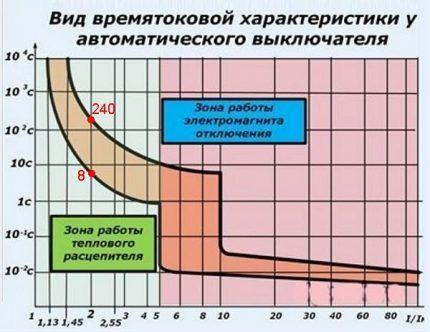
Also, each type of circuit breaker has a defined current range (Ia), at which the instantaneous release mechanism is activated:
- class "B": Ia = (3 * In ..5*In];
- class "C": Ia = (5 * In ..10*In];
- class "D": Ia = (10 * In .. 20 * In].
Type “B” devices are used mainly for lines that are of considerable length. In residential and office premises, class “C” circuit breakers are used, and devices marked “D” protect circuits where there is equipment with a high starting current coefficient.
The standard line of household machines includes devices with ratings of 6, 8, 10, 16, 20, 25, 32, 40, 50 and 63 A.
Structural design of releases
In modern circuit breaker There are two types of releases: thermal and electromagnetic.
A bimetallic release has the shape of a plate created from two conductive metals with different thermal expansion.This design, when exceeding the nominal value for a long time, leads to heating of the part, its bending and the activation of the circuit breaking mechanism.
For some machines, you can use the adjusting screw to change the parameters of the current at which the shutdown occurs. In the past, this technique was often used to “fine-tune” a device, but this procedure requires in-depth specialized knowledge and several tests.

Now on the market you can find many models of standard ratings from different manufacturers, whose time-current characteristics are slightly different (but at the same time comply with regulatory requirements). Therefore, it is possible to select a machine with the necessary “factory” settings, which eliminates the risk of incorrect calibration.
The electromagnetic release prevents overheating of the line as a result of a short circuit. It reacts almost instantly, but the current value must be several times higher than the nominal value. Structurally, this part is a solenoid. The overcurrent generates a magnetic field that moves the core, breaking the circuit.
Compliance with selectivity principles
If there is a branched electrical circuit, it is possible to organize protection in such a way that in the event of a short circuit, only the branch on which the emergency situation occurs is disconnected. For this purpose, the principle of switch selectivity is used.
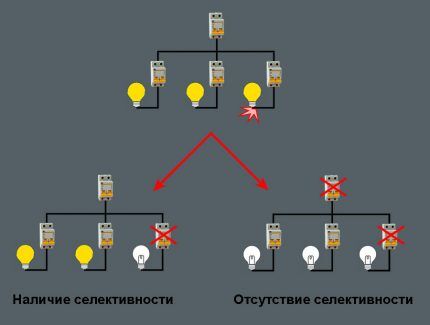
To ensure selective shutdown, instantaneous cutoff circuit breakers are installed at the lower stages, breaking the circuit in 0.02 - 0.2 seconds. The switch located at a higher stage either has an operation delay of 0.25 - 0.6 s or is made according to a special “selective” circuit in accordance with the DIN VDE 0641-21 standard.
For guaranteed security selective operation of machines It is better to use machines from one manufacturer. For switches of a single model range, there are selectivity tables that indicate possible combinations.
The simplest installation rules
The section of the circuit that needs to be protected by a switch can be single- or three-phase, have a neutral, as well as a PE (ground) wire. Therefore, the machines have from 1 to 4 poles, to which the conductor is connected. When conditions for tripping are created, all contacts are disconnected simultaneously.
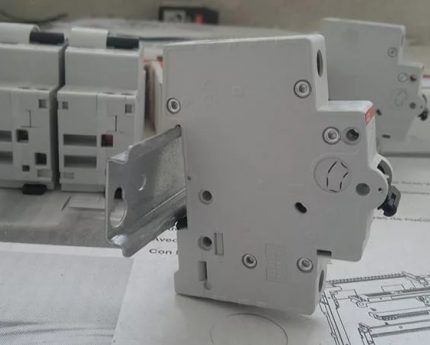
The machines are installed as follows:
- single-pole per phase;
- bipolar for phase and neutral;
- three-pole for 3 phases;
- four-pole for 3 phases and neutral.
However, it is prohibited to do the following:
- install single-pole circuit breakers to neutral;
- insert PE wire into the machine;
- install three single-pole ones instead of one three-pole circuit breaker, if at least one three-phase consumer is connected to the circuit.
All these requirements are specified in the PUE and must be followed.
In every house or room to which electricity is supplied, an introductory machine is installed.Its nominal value is determined by the supplier and this value is specified in the electricity connection agreement. The purpose of such a switch is to protect the area from the transformer to the consumer.
After the introductory machine, a meter (single- or three-phase) is connected to the line and residual current device, the functions of which differ from the operation of the automatic and differential switch.
If the room is wired into several circuits, then each of them is protected by a separate circuit breaker, the power of which indicated on the label. Their ratings and classes are determined by the owner of the premises, taking into account the existing wiring or power of connected devices.
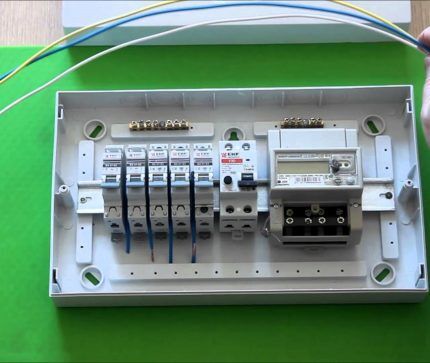
When choosing a location switchboard It must be remembered that the properties of the thermal release are affected by air temperature. Therefore, it is advisable to place the rail with machines inside the room itself.
Calculation of the required denomination
The main protective function of the circuit breaker extends to the wiring, so the rating is selected based on the cable cross-section. In this case, the entire circuit must ensure the normal operation of the devices connected to it. Calculating system parameters is simple, but many nuances must be taken into account in order to avoid errors and problems.
Determination of the total power of consumers
One of the main parameters of the electrical circuit is the maximum possible power of the electricity consumers connected to it. When calculating this indicator, you cannot simply summarize the passport data of devices.
Active and nominal component
For any device powered by electricity, the manufacturer is required to indicate the active power (P). This value determines the amount of energy that will be irrevocably converted as a result of the operation of the device and for which the user will pay on the meter.
But for devices with capacitors or an inductor, there is another power with a non-zero value, which is called reactive (Q). It reaches the device and returns back almost instantly.
The reactive component does not participate in the calculation of used electricity, but together with the active component it forms the so-called “total” or “nominal” power (S), which puts a load on the chain.

It is necessary to calculate the contribution of an individual device to the total load on the conductors and the circuit breaker based on its total power: S = P /cos(f).
Increased starting currents
The next feature of some types of household appliances is the presence of transformers, electric motors or compressors. Such devices consume inrush (starting) current when starting up.
Its value can be several times higher than standard values, but the operating time at increased power is short and usually ranges from 0.1 to 3 seconds. Such a short-term surge will not trigger the thermal release, but the electromagnetic component of the switch, which is responsible for the short-circuit overcurrent, may react.
This situation is especially relevant for dedicated lines to which equipment such as woodworking machines are connected.In this case, you need to calculate the amperage and, perhaps, it makes sense to use a class “D” machine.
Taking into account the demand coefficient
For circuits that have a large amount of equipment connected and no device that consumes the largest portion of the current, use the demand factor (ks). The point of using it is that all devices will not work at the same time, so summing up the rated powers will lead to an overestimated figure.
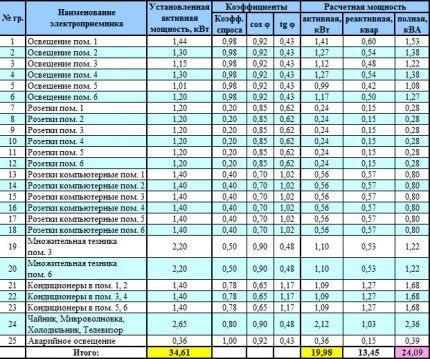
This coefficient can take a value equal to or less than one. Design power calculations (Pr) of each device occurs according to the formula:
Pr = ks * S
The total rated power of all devices is used to calculate the circuit parameters. The use of the demand coefficient is advisable for office and small retail premises with a large number of computers, office equipment and other equipment powered from one circuit.
For lines with a small number of consumers, this coefficient is not used in its pure form. Those devices that are unlikely to be turned on simultaneously with more energy-consuming devices are removed from the power calculation.
So, for example, there is little chance of working in a living room with an iron and a vacuum cleaner at the same time. And for workshops with a small number of personnel, only 2-4 of the most powerful power tools are taken into account.
Current calculation
The machine is selected based on the maximum current value allowed in the circuit section. It is necessary to obtain this indicator, knowing the total power of electrical consumers and the voltage in the network.
According to GOST 29322-2014, from October 2015, the voltage value should be equal to 230 V for a regular network and 400 V for a three-phase network. However, in most cases, the old parameters are still in effect: 220 and 380 V, respectively. Therefore, for accurate calculations, it is necessary to take measurements using a voltmeter.
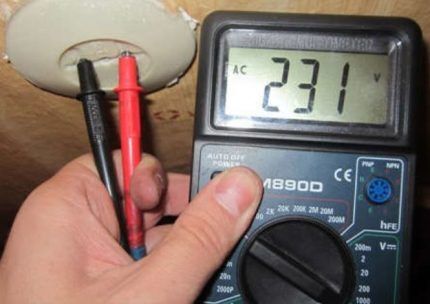
Another problem, especially relevant for electrical wiring in the private sector, is the provision of power supply with insufficient voltage. Measurements at such problematic objects may show values outside the range defined by GOST.
Moreover, depending on the level of electricity consumption of your neighbors, the voltage value can vary greatly within a short time.
This creates a problem not only for the functioning of the devices, but also for current calculation. When the voltage drops, some devices simply lose power, and some that have an input stabilizer increase their electricity consumption.
It is difficult to carry out qualitative calculations of the required circuit parameters under such conditions. Therefore, you will either have to lay cables with a deliberately large cross-section (which is expensive), or solve the problem by installing an input stabilizer or connecting the house to another line.
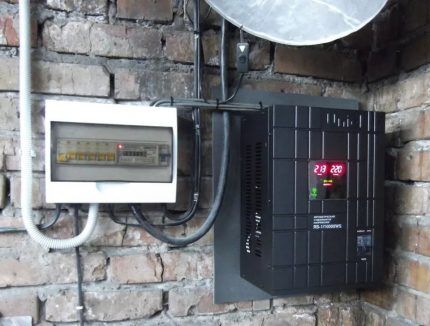
After the total power of electrical appliances has been found (S) and found out the voltage value (U), current calculation (I) are carried out according to formulas that are a consequence of Ohm’s law:
If = S/Uf for single-phase network
Il = S / (1.73 * Ul) for three-phase network
Here the index "f" means phase parameters, and "l» – linear.
Most three-phase devices use the “star” connection type, and it is also according to this circuit that the transformer operates, delivering current to the consumer. With a symmetrical load, the linear and phase forces will be identical (Il = If), and the voltage is calculated using the formula:
Ul = 1.73 * Uf
Nuances of selecting cable cross-section
The quality and parameters of wires and cables are regulated by GOST 31996-2012. According to this document, specifications are developed for manufactured products, where a certain range of values of basic characteristics is allowed. The manufacturer is obliged to provide a table of correspondence between the cross-section of the cores and the maximum safe current.
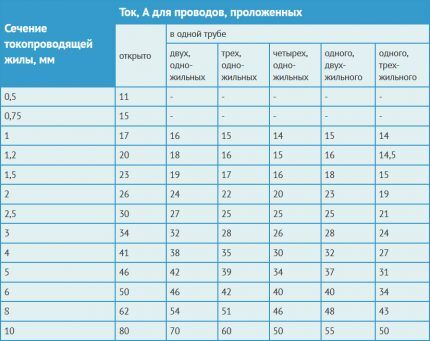
It is necessary to select a cable in such a way as to ensure the safe flow of current corresponding to the calculated total power of electrical appliances. According to the PUE (electrical installation rules), the minimum calculated wire cross-sectionused in residential premises must be at least 1.5 mm2.
Standard sizes have the following values: 1.5; 2.5; 4; 6 and 10 mm2.
Sometimes there is a reason to use wires with a cross-section one step larger than the minimum allowable. In this case, it is possible to connect additional devices or replace existing ones with more powerful ones without expensive and time-consuming work on laying new cables.
Calculation of machine parameters
For any circuit the following inequality must be satisfied:
In <=Ip / 1.45
Here In – rated current of the machine, and Ip – permissible current for wiring. This rule ensures guaranteed release when the permissible load is exceeded for a long time.

The rating of the machine can be calculated both by the total load and by the cross-section of the wires of the already installed wiring. Let's say that there is a diagram for connecting electrical appliances, but the wiring has not yet been laid.
In this case, the sequence of actions is as follows:
- Calculation of the total current strength of electrical appliances connected to the network.
- Select a machine with a denomination not less than the calculated value.
- Selection of cable cross-section according to the machine's rating.
Example:
- S = 4 kW; I = 4000 / 220 = 18 A;
- In = 20 A;
- Ip >=In * 1.45 = 29 A; D = 4 mm2.
If the wiring has already been laid, then the sequence of actions is different:
- Determination of the permissible current for a known cross-section and method of wiring according to the table provided by the manufacturer.
- Selection of circuit breaker.
- Calculation of the power of connected devices. Equipping a group of devices in such a way that the total load on the circuit is less than the nominal value.
Example. Let two single-core cables be laid openly, D = 6 mm2, Then:
- Ip = 46 A;
- In <=Ip / 1.45 = 32 A;
- S = In * 220 = 7.0 kW.
In point 2 of the last example there is a slight acceptable approximation. Exact value of In = Ip / 1.45 = 31.7 A rounded to 32 A.
Choice between several denominations
Sometimes a situation arises when you can select several machines with different ratings to protect the circuit.For example, with a total power of electrical appliances of 4 kW (18 A), wiring with a copper core cross-section of 4 mm was chosen with a reserve2. For this combination, you can install 20 and 25 A switches.
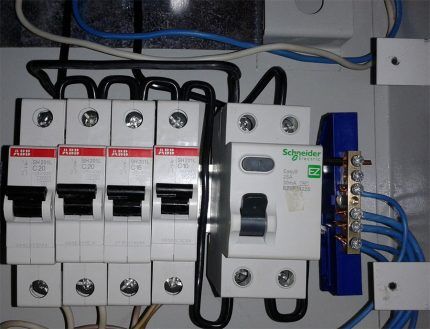
The advantage of choosing a switch with the highest rating is the ability to connect additional devices without changing the circuit elements. Most often this is what they do.
The choice of a machine with a lower rating is supported by the fact that its thermal release will respond faster to an increased current. The fact is that some devices may have a malfunction, which will lead to an increase in energy consumption, but not to the point of a short circuit.
For example, a failure of a washing machine motor bearing will lead to a sharp increase in current in the winding. If the machine quickly reacts to exceeding the permitted values and switches off, the motor will not burn out.
Conclusions and useful video on the topic
Design of a circuit breaker and its classification. The concept of time-current characteristics and selection of rating according to the cable cross-section:
Calculation of the power of devices and selection of a machine using the provisions of the PUE:
The choice of circuit breaker must be taken responsibly, since the safety of the electrical system at home depends on it. With all the many input parameters and calculation nuances, it is necessary to remember that the main protective function of the machine applies to the wiring.
Please write comments, ask questions, and post photos related to the topic of the article in the block below. Share useful information that may be useful to site visitors. Tell us about your own experience in choosing circuit breakers to protect country or home electrical wiring.



